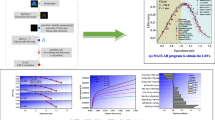Abstract
The suppression of CH4 and CH3OH premixed flames with CBrF3 and CF3I is examined, using computational techniques. By combining sensitivity analysis, reaction pathway analysis (based on carbon, hydrogen, bromine and iodine atom fluxes) and heat release estimation, we develop an explanation for the difference of suppression efficiencies which is qualitatively consistent with experimental cup burner data. The key reaction steps and channels responsible for the (apparent) higher inhibition efficiency of CF3I compared to CBrF3 in CH3OH premixed flames are disclosed, by combining reaction pathway and heat release contribution analysis. The reaction of bromine atom dominates the decomposition channel for CH3OH but plays a relatively minor role in the activation of CH4, while I atom plays a minor role in CH3OH or CH4 activation. Accordingly, the rate of production of flame propagating radicals CH2O and OH is higher in a CH3OH–air–CBrF3 system than in a CH3OH–air–CF3I system. The overall conclusion is that CBrF3 contributes significantly to flame propagation for CH3OH fuel reactions and consequently more CBrF3 is required to extinguish a CH3OH flame than CF3I. Finally the explanation is validated by applying the reaction “switching-off” test.







Similar content being viewed by others
References
E.J.P. Zegers, B.A. Williams, E.M. Fisher, J.W. Fleming, and R.S. Sheinson, Suppression of nonpremixed flames by fluorinated ethanes and propanes. Combustion and Flame, 2000. 121(3): p. 471-487
T.A. Moore, C.A. Weitz, and R.E. Tapscott, “Update on NMERI Cup-Burner Test Tesults”, in Halon Options Technical Working Conference (HOTWC 1996). Albuquerque, NM, 1996.
T. Noto, V. Babushok, D.R. Burgess Jr., A. Hamins, and W. Tsang, “Effect of Halogenated Flame Inhibitors on C1-C2 Organic Flames”, Symposium (International) on Combustion [Proceedings]. 26th(Vol. 1), 1996, pp. 1377-1383.
T. Noto, V. Babushok, A. Hamins, and W. Tsang, “Inhibition Effectiveness of Halogenated Compounds”. Combustion and Flame, 1998. 112(1-2): p. 147-160
V. Babushok and W. Tsang, “Inhibitor rankings for alkane combustion”. Combustion and Flame, 2000. 123(4): p. 488-506
C. Luo, "Study on the Inhibition Mechanisms of CBrF3, CF3I and C3F7H in a CH4 Fuelled Premixed Flame”, Ph.D. Thesis, Department of Chemical Engineering, Callaghan, The University of Newcastle, Australia, 2008.
C. Luo, B.Z. Dlugogorski, B. Moghtaderi, and E.M. Kennedy, “Computational Study on Toxic Gases Released from Compartment Fires Suppressed with Halogenated Agents”. Cybernetics & Systems, 2004. 35(7/8): p. 607-625
C. Luo, B.Z. Dlugogorski, and E.M. Kennedy, “Effect of Hydrofluorocarbons and Perfluorocarbons on Suppression Efficiency of CF3I”, in Halon Options Technical Working Conference, 14th. Proceedings. HOTWC 2004. NIST SP 984-2; NIST Special Publication 984-2. Albuquerque, NM, 2004.
G.T. Linteris and L. Truett, “Inhibition of Premixed CH4 - Air Flames by Fluoromethanes”. Combustion and Flame, 1996. 105(1-2): p. 15-27
B. Moghtaderi, B.Z. Dlugogorski, and E.M. Kennedy, “A Detailed Chemical Kinetic Modelling Study on High Temperature Ignition of CH4/Air Mixtures Doped with C3F7H”, in Halon Options Technical Working Conference. Albuquerque, USA, 1998.
Author information
Authors and Affiliations
Corresponding author
Rights and permissions
About this article
Cite this article
Luo, C., Dlugogorski, B.Z. & Kennedy, E.M. Influence of CF3I and CBrF3 on Methanol–Air and Methane–Air Premixed Flames. Fire Technol 44, 221–237 (2008). https://doi.org/10.1007/s10694-007-0033-5
Received:
Accepted:
Published:
Issue Date:
DOI: https://doi.org/10.1007/s10694-007-0033-5




